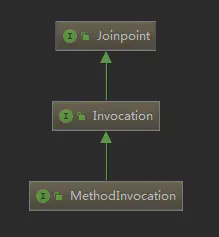SpringAOP[5]-MethodInvocation(拦截器的调用)
原文:SpringAOP联盟(5)-MethodInvocation(拦截器的调用) - 简书 (jianshu.com)
在上文中,代理对象创建后,最终的拦截工作都是交给了MethodInvocation。JDK交给了ReflectiveMethodInvocation,而CGLIB交给CglibMethodInvocation。
此处所说的MethodInvocation是AOP联盟包下的,也就是org.aopalliance.intercept.MethodInvocation。
此接口会继承Joinpoint接口,注意不要和org.aspectj.lang.JoinPoint搞混。
org.aspectj.lang.JoinPoint:该对象封装了SpringAop中切面方法信息,在切面方法添加JoinPoint参数,可以很方便的获取更多信息。(一般用于@Aspect标注的切面方法入参)。org.aopalliance.intercept.Joinpoint是AOP联盟中的类,关系如下图所示:

//此接口表示运行时的连接点(AOP术语) public interface Joinpoint { //执行此拦截点,并进入下一个连接点 Object proceed() throws Throwable; //保存当前连接点静态对象,这里一般指的是target Object getThis(); //返回此静态连接点,一般就为当前的Method AccessibleObject getStaticPart(); }
public interface Invocation extends Joinpoint { //获取参数,例如方法的参数 Object[] getArguments(); }
// 方法调用时,对这部分进行描述 public interface MethodInvocation extends Invocation { // 返回正在被调用得方法,返回的是当前Method对象。 // 此时,效果同父类的AccessibleObject getStaticPart() 这个方法 Method getMethod(); }
MethodInvocation作为aopalliance里提供的最底层的接口。Spring也提供了相关的实现。

Spring也提供了一个接口
proxyMethodInvoation来进行扩展使用。public interface ProxyMethodInvocation extends MethodInvocation { //返回代理对象 Object getProxy(); //clone一个,使用的是Object的clone方法 MethodInvocation invocableClone(); MethodInvocation invocableClone(Object... arguments); //设置参数 增强器、通知执行的时候可能会使用到 void setArguments(Object... arguments); //添加一些kv,但这些kv并不会用于AOP框架,而是保存起来给特殊的拦截器使用 void setUserAttribute(String key, @Nullable Object value); @Nullable Object getUserAttribute(String key); }
1. ReflectiveMethodInvocation
Spring提供的实现类:org.springframework.aop.framework.ReflectiveMethodInvocation
该类作为实现类,会实现包含父父类所有的抽象方法。
他也是JdkDynamicAopProxy最终要new出来的类。
public class ReflectiveMethodInvocation implements ProxyMethodInvocation, Cloneable { protected final Object proxy; // 代理对象 @Nullable protected final Object target; // 目标对象 protected final Method method; // 被拦截的方法 protected Object[] arguments = new Object[0]; @Nullable private final Class<?> targetClass; @Nullable private Map<String, Object> userAttributes; protected final List<?> interceptorsAndDynamicMethodMatchers; // currentInterceptorIndex初始值为 -1(拦截链初始值为-1) private int currentInterceptorIndex = -1; //Spring内部使用的类 protected ReflectiveMethodInvocation( Object proxy, @Nullable Object target, Method method, @Nullable Object[] arguments, @Nullable Class<?> targetClass, List<Object> interceptorsAndDynamicMethodMatchers) { this.proxy = proxy; this.target = target; this.targetClass = targetClass; // 找到桥接方法,作为最后执行的方法。 this.method = BridgeMethodResolver.findBridgedMethod(method); // 对参数进行适配 this.arguments = AopProxyUtils.adaptArgumentsIfNecessary(method, arguments); this.interceptorsAndDynamicMethodMatchers = interceptorsAndDynamicMethodMatchers; } @Override public final Object getProxy() { return this.proxy; } @Override @Nullable public final Object getThis() { return this.target; } // 此处:getStaticPart返回的就是当前得method @Override public final AccessibleObject getStaticPart() { return this.method; } // 注意:这里返回的可能是桥接方法哦 @Override public final Method getMethod() { return this.method; } @Override public final Object[] getArguments() { return this.arguments; } @Override public void setArguments(Object... arguments) { this.arguments = arguments; } //这里是执行的核心,要执行方法,执行通知都是在此处搞定的。 //这里是递归调用的方式,执行所有的过滤器链 @Override @Nullable public Object proceed() throws Throwable { // currentInterceptorIndex初始值为 -1 如果执行到链条的末尾 则直接调用连接点方法 即 直接调用目标方法 if (this.currentInterceptorIndex == this.interceptorsAndDynamicMethodMatchers.size() - 1) { // 这个方法相当于调用了目标方法~~~下面会分析 return invokeJoinpoint(); } // 获取集合中的 MethodInterceptor(并且currentInterceptorIndex + 1了哦) Object interceptorOrInterceptionAdvice = this.interceptorsAndDynamicMethodMatchers.get(++this.currentInterceptorIndex); //InterceptorAndDynamicMethodMatcher它是Spring内部使用的一个类。很简单,就是把MethodInterceptor实例和MethodMatcher放在了一起。看看在advisor chain里面是否能够匹配上 if (interceptorOrInterceptionAdvice instanceof InterceptorAndDynamicMethodMatcher) { InterceptorAndDynamicMethodMatcher dm = (InterceptorAndDynamicMethodMatcher) interceptorOrInterceptionAdvice; // 去匹配这个拦截器是否适用于这个目标方法 试用就执行拦截器得invoke方法 if (dm.methodMatcher.matches(this.method, this.targetClass, this.arguments)) { return dm.interceptor.invoke(this); } else { // 如果不匹配。就跳过此拦截器,而继续执行下一个拦截器 // 注意:这里是递归调用 并不是循环调用 return proceed(); } } else { // 直接执行此拦截器。说明之前已经匹配好了,只有匹配上的方法才会被拦截进来的 // 这里传入this就是传入了ReflectiveMethodInvocation,从而形成了一个链条了 return ((MethodInterceptor) interceptorOrInterceptionAdvice).invoke(this); } } /** ** AopUtils.invokeJoinpointUsingReflection源码: ** ReflectionUtils.makeAccessible(method); ** return method.invoke(target, args); **/ //方法调用时简单的`method.invoke(target, args);`。 //子类可以复写该方法,比如唯一子类`CglibAopProxy`内部类`CglibMethodInvocation`就复写了这个方法(后续有介绍) @Nullable protected Object invokeJoinpoint() throws Throwable { //此处传入的是target,而不能是proxy。否则会进入死循环 return AopUtils.invokeJoinpointUsingReflection(this.target, this.method, this.arguments); } }
2. CglibMethodInvocation
它是
并且
ReflectiveMethodInvocation的唯一子类,是Cglib自己使用的执行器。你可以将其看做为工厂模式,它会实现一些Cglib特有的方法。并且
CglibMethodInvocation是CglibAopProxy的静态内部类。private static class CglibMethodInvocation extends ReflectiveMethodInvocation { @Nullable private final MethodProxy methodProxy; public CglibMethodInvocation(Object proxy, @Nullable Object target, Method method, Object[] arguments, @Nullable Class<?> targetClass, List<Object> interceptorsAndDynamicMethodMatchers, MethodProxy methodProxy) { super(proxy, target, method, arguments, targetClass, interceptorsAndDynamicMethodMatchers); //做出了特殊处理,methodProxy是子类特有的参数,表示被CGLIB拦截的时候的类 //MethodProxy:为生成代理类对方法的代理引用,使用MethodProxy比直接调用JDK本身的Method直接执行方法效率会有提升。 //MethodProxy有两个重要的方法:invoke和invokeSuper。 //method.getDeclaringClass用来判断当前这个方法是哪个类的方法。 //若该方法是public方法 且 method不是Object类的方法 且 method不是equals 且 method不是 hashCode 且 method不是toString方法,返回methodProxy对象。 this.methodProxy = (Modifier.isPublic(method.getModifiers()) && method.getDeclaringClass() != Object.class && !AopUtils.isEqualsMethod(method) && !AopUtils.isHashCodeMethod(method) && !AopUtils.isToStringMethod(method) ? methodProxy : null); } @Override protected Object invokeJoinpoint() throws Throwable { if (this.methodProxy != null) { //如果符合上述条件,调用methodProxy去执行目标方法。(使用FastClass调用) return this.methodProxy.invoke(this.target, this.arguments); } else { return super.invokeJoinpoint(); } } }
那些
@AspectJ定义的通知(增强器),或者自己实现的MethodBeforeAdvice、AfterReturningAdvice...最终都会被包装为一个org.aopalliance.intercept.MethodInterceptor,交由MethodInvocation(其子类是ReflectiveMethodInvocation)去执行,它会将该方法上的拦截器链缓存,并递归调用执行。推荐阅读
分类:
SpringBoot
标签:
SpringAOP
, SpringBoot






【推荐】国内首个AI IDE,深度理解中文开发场景,立即下载体验Trae
【推荐】编程新体验,更懂你的AI,立即体验豆包MarsCode编程助手
【推荐】抖音旗下AI助手豆包,你的智能百科全书,全免费不限次数
【推荐】轻量又高性能的 SSH 工具 IShell:AI 加持,快人一步
· 开发者必知的日志记录最佳实践
· SQL Server 2025 AI相关能力初探
· Linux系列:如何用 C#调用 C方法造成内存泄露
· AI与.NET技术实操系列(二):开始使用ML.NET
· 记一次.NET内存居高不下排查解决与启示
· Manus重磅发布:全球首款通用AI代理技术深度解析与实战指南
· 被坑几百块钱后,我竟然真的恢复了删除的微信聊天记录!
· 没有Manus邀请码?试试免邀请码的MGX或者开源的OpenManus吧
· 园子的第一款AI主题卫衣上架——"HELLO! HOW CAN I ASSIST YOU TODAY
· 【自荐】一款简洁、开源的在线白板工具 Drawnix
2018-11-16 NumPy库